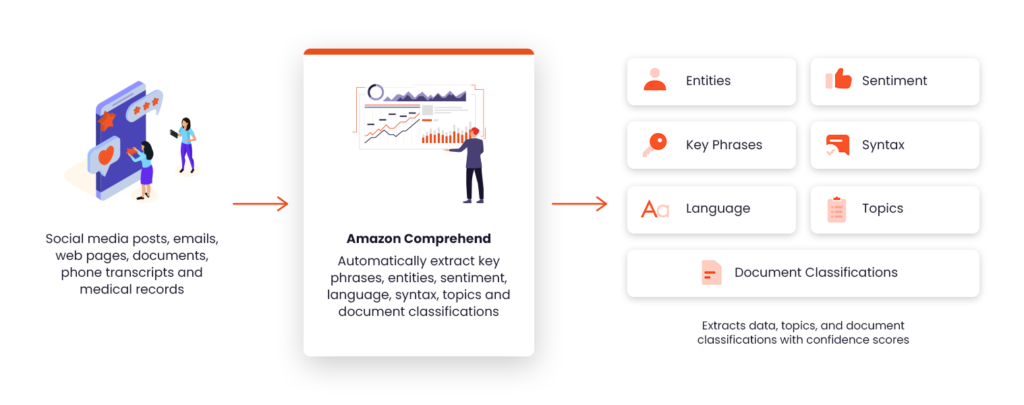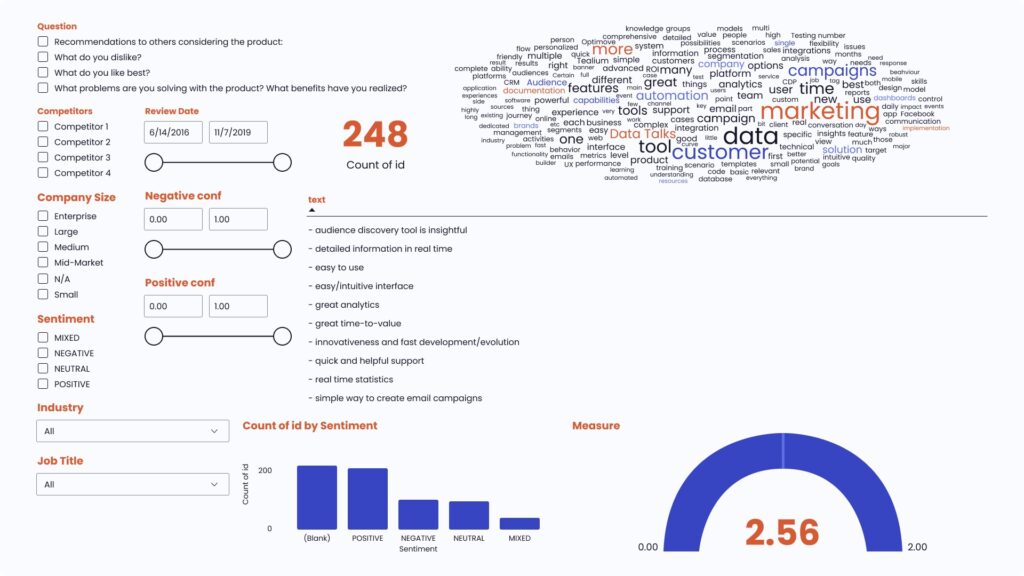How to use Social Sentiment to boost your Marketing and Product development [use case]
November 9, 2020When was the last time that you received customer feedback?
And more importantly, do you know how to automatically collect, analyze and turn it into actionable intelligence?
Understanding how users feel about your brand helps you keep your marketing and product development efforts on track. It also allows you to respond right away to positive or negative input.
Thus, it is important to continuously track your brand’s social media channels and product reviews websites (i.e. g2 crowd, capterra, google reviews) and look out for any red flags. That’s where social listening comes in.
What is Social Listening
Social listening is the process of tracking mentions of certain words, phrases, or even complex queries across the web, followed by an analysis of the data.
Hence it helps you to understand why and where these conversations are happening, as well as what people think about your company; not just when they are tagging or mentioning your brand. This feedback can be beneficial for your future marketing campaigns since it can give you input on how to improve your content strategy and messaging, construct an effective loyalty program or even build more impactful brand partnerships.
Despite its name, social listening isn’t just about social media: many listening tools also monitor news websites, blogs, forums, and the rest of the web. Thus, you might ‘listen’ to what product features and functionality your users (or your competitors’ users) long for and pass this feedback to your product development team.
There are several tools available online to help you analyze the results of your social listening.
But is this enough?
Wouldn’t it be great to understand how people feel about your brand? This is where the social sentiment kicks in.
What is Social Sentiment
Social sentiment, also known as brand sentiment, is a way of measuring the emotions behind any online mention. Social sentiment can be:
- Positive: users are enthusiastic, happy, or excited.
- Negative: users are angry, annoyed, or frustrated.
- Neutral: users seem satisfied but don’t express any particular feelings.
Why is Social Sentiment important?
Social sentiment doesn’t just look at how many people are talking about your business. It adds context by measuring the tone of those conversations, comments, and mentions. It helps you understand what someone behind an online post is feeling. Knowing the emotion behind a post can provide important context for how you proceed and respond.
Without sentiment, data can be misleading. If your company receives a large number of mentions on social media while launching a new feature, you might assume the launch has been successful. However, if the majority of posts are negative, then the opposite is true.
The presence of negative sentiment doesn’t, however, mean that a product or brand is a failure. The ratio of positive to negative is also important. Not every consumer will love your business. Even those who are loyal customers will sometimes discover products they don’t like or have a negative experience. Thus, as long as the majority of customers have neutral to positive feelings toward your company, your overall social sentiment will be positive.
How to measure Social Sentiment?
Measuring social sentiment can be challenging, depending on the size of your company and the number of online mentions of your brand. However, just because something is difficult to measure doesn’t mean you shouldn’t try to measure and track it. So where do you start?
That’s easy! One approach would be to read through each and every post while assigning a numerical score based on the tone of each post. But this is a tedious and time-consuming process.
A better approach is to perform a Social Sentiment analysis using Natural Language Processing (NLP), given that you have consolidated all of your online mentions into one place (does the CDP word ring a bell? 🙂 ).
Intrigued? Let’s dive into it.
All data that you gathered via your social listening or social sentiment activities is most likely unstructured data; it could be anything from customer emails, support tickets and online product reviews to social media posts. So, how do you analyze this?
Natural language processing is a field in machine learning that can help computers accurately identify specific items of interest inside vast texts and can learn the sentiment hidden inside language (identifying negative reviews, or positive customer interactions with customer service agents), at almost limitless scale. The best part? You don’t have to build, train or deploy the model by yourself since there are services who can do the heavy lifting for you.
5 Real-World Sentiment Analysis Use Cases
#1 Determine which customer segments have strong opinions
Sentiment analysis can help you identify your brand ambassadors (you don’t want to neglect those!) but also those that feel negatively about your brand for whatever reason, providing you an opportunity to start a dialogue with them. Maybe they don’t like your return process or they think that your customer service is difficult to reach. By addressing their concerns, you can convert them to loyal customers.
#2 Input for Product Improvements
Sentiment analysis makes it possible to understand what people loved or didn’t love about your latest product release. It basically ‘massages’ your unstructured data and converts it into insights that you can use as input/feedback for your Product team. In addition you can track if there are any complaints over time about “ease of use” that you should be worried about or just attribute it to a new product learning curve.
#3 Prioritize Customer Service Issues
Customer support tickets tend to be answered in order of submission, but is that the best approach? Companies can use sentiment analysis to put top priority customer service tickets at the head of the queue. Done strategically, this can help companies quickly address negative feedback and avoid escalations.
#4 Correlate customer feelings with their online touchpoints
By pairing demographic and other quantitative data, it is possible to segment the customer base and look at their sentiment in isolation. For example, do customers who spend less feel more negatively (and therefore it is a barrier to them spending more) or do unhappy customers return orders more frequently and what is the cost associated with it?
#5 SWOT analysis of your competition
There is one thing that you and your competitors have in common – a target audience. You can track and research how society evaluates competitors just as you analyze their attitude towards your business.
What do customers value most about other industry players? Is there anything competitors lack or do wrong? Which channels do clients use to engage with other companies?
You can then use this knowledge to improve your communication and marketing strategies (or overall offering) and provide services & products your customers would appreciate.
In the section below, I thought that it would be nice to share with you how my awesome colleague Ali Salih and I implemented the last use case for Data Talks’ competitors to inspire you.
Use case: SWOT analysis of your competition
Have you ever thought about doing a SWOT analysis on your competition?
We sure did!
By thoroughly evaluating your competitors, you can learn to deal with their strengths, capitalize on their weaknesses, take advantage of any opportunities they present, and handle any threats they pose.
We were so convinced that this would give us great insights, that we actually spent some time on creating a proof of concept (PoC) for Data Talks. The whole project duration was less than a working day which is amazing if you consider that you build the process for analyzing this feedback for future cases as well.
Now we want to share that process with you (you’re welcome!)
Below are the 3 steps that we took and some screenshots included as well for further clarification.
#1. Get online customer reviews of your biggest competitors
We’ve used a Python script to crawl customer reviews of our competitors via G2 crowd, Capterra and TrustRadius. We couldn’t find customer feedback on Google reviews or any other similar software but these data points were enough for our proof of concept.
Once the data was fetched, we used the Data Talks Integrator to insert the data in a Data Lake and then the cleaning/transformation process started. Keep in mind that people don’t submit feedback the same way in all peer-to-peer review websites.
#2. Use Amazon Comprehend to find insights and relationships in text
Amazon Comprehend is a natural language processing (NLP) service that uses machine learning to find insights and relationships in text. No machine learning experience required.
Comprehend consists of 5 components
- Keyphrase extraction → returns keywords or phrases with a level of significance in a text.
- Sentiment analysis → returns sentiments (positive, negative, neutral or mixed) with the percentual share of each sentiment in the text.
- Syntax analysis → identifies and returns if the word is a noun, verb etc.
- Entity recognition → returns the type of entity described s.a (places, people, time) etc.
- Language detection → Comprehend can detect over 100 written languages and also return the level of confidence.
Here is how it works:

#3 Data Visualization in a business intelligence software
We wanted to analyze the results thus we created an interactive dashboard, where we applied various filters and played around. It was important to check the date of the comments so that we get relevant feedback but also understand the overall sentiment.
The end result looked like the graph below.

- On the left side, you can see the various dimensions; basically we have tried to structure the dataset based on the given dimensions.
- In addition, we have used a word cloud (otherwise known as a tag cloud, wordle or word collage, which is a digital image of words that can be displayed in different colours to highlight key themes or topics) to understand the frequency of the words mentioned (the bigger the word, the higher the frequency in the text)
- The actual comments are in the middle, called text. Here we can actually read the feedback submitted from each user.
- Count of id by Sentiment: #comments by sentiment, which illustrates how many positive/negative/neutral/mixed comments we processed
- Measure: indicating the level of positiveness (#positive sentiments/#negative sentiment)
As a next step, if this wasn’t just a PoC, we could connect our project management software via an API and pass the feedback (specific comments to the product team) while sending relevant feedback to customer support as well.
Bringing it all together, sentiment analysis could be a game changer for your Marketing and Product development, or Customer Success teams if you manage to harness its potential. I would urge you to start simple, from any of the use cases described above and if you need help, feel free to reach out to me 🙂


